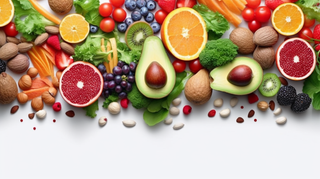Ever feel like you're constantly reaching for another snack? It might be a sign your body is craving more protein. This essential macronutrient plays a vital role in building and repairing tissues, keeping you feeling full, and supporting a healthy metabolism. As a qualified naturopath with extensive experience in helping patients achieve optimal health, I understand the importance of a balanced diet rich in protein.
Key Takeaways Table:
| Food Group | Protein per Serving (average) | Additional Benefits |
|---|---|---|
| Lean Meats & Poultry | 20-30 grams | Iron, Zinc, Vitamin B12 |
| Fish & Shellfish | 20-25 grams | Omega-3 Fatty Acids, Vitamin D |
| Eggs | 6-8 grams | Healthy Fats, Choline |
| Dairy | 8-10 grams per serving (varies) | Calcium, Vitamin D |
| Legumes | 15-20 grams | Fiber, Folate |
| Nuts & Seeds | 5-10 grams per serving (varies) | Healthy Fats, Fiber, Minerals |

Protein Powerhouses: A Breakdown by Food Group
This detailed breakdown equips you to identify protein-rich options across various food groups:
- Lean Meats & Poultry: Chicken breast, turkey breast, lean cuts of beef, and skinless fish are excellent sources of high-quality protein, containing around 20-30 grams per 3-ounce serving. These choices are also relatively low in fat and calories, making them ideal for weight management and muscle building.
-
Fish & Shellfish: Salmon, tuna, shrimp, and scallops are protein powerhouses, offering 20-25 grams of protein per serving. They're packed with omega-3 fatty acids, essential for heart and brain health.
-
Eggs: A breakfast staple for a reason! Eggs are a complete protein source, containing all nine essential amino acids your body needs. One large egg boasts around 6-8 grams of protein, along with healthy fats and choline, which is crucial for brain function.
-
Dairy: Greek yogurt, cottage cheese, and low-fat milk are fantastic protein options, providing 8-10 grams per serving (depending on the product). Dairy is also an excellent source of calcium and vitamin D, essential for bone health.
- Legumes: Don't underestimate the power of plants! Lentils, chickpeas, beans, and peas are protein champions in the vegetarian and vegan world. They offer a hearty 15-20 grams of protein per cooked cup, along with fiber and folate, promoting gut health and cell function.
- Nuts & Seeds: A delicious and convenient protein snack! Almonds, walnuts, chia seeds, and pumpkin seeds are powerhouses of protein, healthy fats, and various minerals. They provide a satisfying crunch with 5-10 grams of protein per serving (depending on the nut or seed).

Frequently Asked Questions (FAQs):
-
How much protein do I need daily? This depends on several factors, including age, activity level, and weight. Generally, adults need 0.8 grams of protein per kilogram of body weight. However, I recommend consulting a naturopath to determine your personalized protein needs.
-
Are protein bars a good source of protein? Protein bars can be a convenient option, but be mindful of added sugars, artificial sweeteners, and unhealthy fats. Choose bars with at least 10 grams of protein and limited processed ingredients.
-
What are some high-protein breakfast ideas? Scrambled eggs with vegetables, Greek yogurt with berries and nuts, or a protein smoothie made with protein powder, fruits, and spinach are all excellent choices for a protein-packed start to your day.
- I'm looking for high-protein snacks to curb cravings. What are some options? Hard-boiled eggs, a handful of almonds, edamame, or a small container of Greek yogurt with berries are all satisfying and protein-rich snacks that can help keep you feeling full between meals.
A Naturopath's Recommendation
Lifestyle: Good nutrition goes hand in hand with balanced lifestyle - it is just as important to make time for stress management such as self care, to truly unwind; prioritize sleep, get in daily movement and make time to plan your weekly meals! This makes sticking to an 80/20 healthy eating pattern much easier and more efficient (not to mention cost effective!).
Beyond the Basics: Protein Quality, Digestion, and Building a Balanced Plate
Understanding protein content is just the first step. Delving deeper into protein quality, digestion, and how to create a balanced plate empowers you to make informed dietary choices that support your unique needs.
Protein Quality: Not All Protein is Created Equal
The human body requires a specific set of building blocks called amino acids to create and repair tissues. There are 20 different amino acids, and nine of them are classified as essential, meaning your body cannot produce them on its own and must obtain them from your diet.
High-Biological-Value Protein:
- Animal sources like lean meats, poultry, fish, eggs, and dairy protein are considered complete proteins, containing all nine essential amino acids in sufficient amounts.
- This makes them highly bioavailable, meaning your body can easily absorb and utilize the amino acids for various functions.
Building a Complete Protein Profile from Plant-Based Sources:
- Plant-based proteins like legumes, nuts, and seeds are generally considered incomplete proteins, as they lack one or more essential amino acids.
- However, by strategically combining these plant-based protein sources throughout the day, you can create a complete amino acid profile.
- For example, pairing brown rice and beans provides a complementary protein source, with each offering the essential amino acids the other lacks.
Naturopathic Insights: Optimizing Protein Digestion and Absorption
As a naturopath, I understand that proper digestion is vital for maximizing protein absorption. Here are some tips to consider:
- Chew Thoroughly: This allows your body to break down protein into smaller peptides for easier absorption in the small intestine.
- Eat a Variety of Protein Sources: This ensures you're getting a complete range of amino acids and reduces the stress on your digestive system from constantly processing the same protein source.
- Support Gut Health: A healthy gut microbiome plays a crucial role in protein digestion. Consider incorporating fermented foods like yogurt, kefir, and kimchi into your diet, or discuss the potential benefits of probiotic supplementation with your naturopath.
High Protein Foods: An Informative List to Fuel Your Day
Plant-Based Protein Foods: Power Up Your Diet Naturally
The Role of Nutritional Coaching: Customizing Diet Plans for Optimal Health
Creating a Balanced Plate: Putting it All Together
Now that you understand protein content, quality, and digestion, let's explore how to incorporate these protein-rich options into a balanced and satisfying meal plan:
-
Portion Control: While protein is essential, moderation is key. Aim for 3-4 ounce servings of protein per meal, roughly the size of your palm.
-
Colorful Companions: Don't forget about the importance of carbohydrates, healthy fats, fiber, and essential vitamins and minerals. Pair your protein with colorful fruits and vegetables, whole grains, and healthy fats like avocados or olive oil for a well-rounded meal.
Sample Balanced Meals with Protein Powerhouses:
- Lunch: Grilled salmon with roasted vegetables and quinoa
- Dinner: Lentil soup with a whole-wheat bread roll and a side salad
- Snack: Apple slices with almond butter
Remember, this is just a starting point! Consult your naturopath for personalized guidance on creating a protein plan that aligns with your specific health goals and dietary needs. By working together, we can create a sustainable and enjoyable approach to achieving optimal health through the power of protein.
Balanced diet is key! While protein is crucial, don't neglect carbohydrates, healthy fats, and essential vitamins and minerals for optimal health. As your trusted naturopathic resource, I encourage you to explore incorporating these protein-rich choices into your meals and snacks. By fueling your body with the right nutrients, you'll be well on your way to achieving your health









